Features of planting sage and caring for it in the open field
When growing sage outdoors, it is necessary to properly organize the planting of the plant and provide regular care for it. With due care, wonderful bushes will become a worthy decoration of any flower garden.
Types and varieties
Sage is a semi-shrub from the Yasnotkovy family up to 75 cm high. The stem is lignified in the root zone. On the shoots, wedge-shaped leaves up to 8 cm long and 1-3 cm wide are densely located. The racemose inflorescences of violet-blue, white or pink color appear in the second year of life, from May to July. There are one-, two- and perennial varieties of sage.
- Medicinal sage (salvia) - the most famous representative of the family. It is actively used in cooking and medicine. There are many hybrids of this species. The flowers are purple and the shades of the leaves are varied. There are specimens with reddish, lilac and silvery foliage, some with bright golden-white spots.
- Clary sage attracts with rich taste and smell, as well as large light purple inflorescences. It is used to brew aromatic tea, used in bouquets.
- Pineapple variety - an autumn plant with a fruity taste and scarlet flowers, which in winter is transferred to a room with a positive temperature. It is used to make herbal tea.
- Oak sage (summer) Is a perennial with fragrant leaves and dark purple flowers that delight from late spring to early summer. If you prune the bush at soil level in early August, it will bloom again in September. Hardy and durable plant with vigorous growth.
- Mealy sage - a dim, fast-growing type of green.
- Sage Voznesensky 24 - plant up to 2 m tall, with large heart-shaped leaves of dark green color. There are perennial and biennial varieties. Blooms already in the year of planting. The flower has a green calyx, a violet-blue upper lip and a creamy white lower lip.
Sage species can be cross-pollinated if they grow side by side. To preserve the specific features, they are planted as far as possible from each other. This is especially true for rare perennial varieties.
Medicinal properties and contraindications
Sage is widely used not only for decorating personal plots. Other beneficial qualities of the flower are known.
- Salvia is used for diseases of the stomach, lungs, liver and kidneys.
- Used for viral, gynecological and skin diseases.
- The plant has anti-inflammatory and antimicrobial properties.
- Sage essential oils can help fight stress and headaches.
- It is a valuable source for the manufacture of perfumery and cosmetics.
- A fragrant spice with a tart taste is used in cooking.
- Sage is a wonderful honey plant. The honey collected from the plantations of this plant has a pleasant aroma and golden color.
Sage should not be used for pregnant and lactating women, for breast cancer and acute inflammatory processes in the kidneys. Hypertensive patients should use salvia with caution, as it can increase blood pressure. You should not use sage for more than three months without a break: some plant substances accumulate in the body and can cause poisoning.
How does sage breed?
There are 4 main ways of plant propagation: seeds, shoots, dividing the bush and layering.
- Seeds.
This is the most popular method. In February or March, seeds are placed in the prepared nutrient substrate. Planting is watered regularly.After about a decade, the first shoots appear. Seedlings dive at three weeks of age. When the weather is warm, young plants are transferred outside, to a permanent growing area.
You can sow seeds directly into open ground by first soaking them in a growth promoter. In May, seeds are introduced into the prepared soil to a depth of 3 cm. The distance between adjacent specimens is not less than 30 cm, row spacing is not less than 50 cm. The first shoots appear in about 2-3 weeks. The land in the area with young growth is regularly moistened, preventing the soil from drying out.
- Shoots.
From semi-lignified shoots, shoots about 15 cm long are cut. The cuttings are placed in water so that roots appear. After two weeks, newly formed plants are planted in the ground.
- Dividing the bush and layering.
In early spring or late summer, you can plant an overgrown bush, separating the adventitious processes. Cutting is obtained by bending a branch of a growing flower to the soil. It is fixed with a wire at a distance of about 10 cm from the top. In less than a month, the cuttings will take root - and it can be transplanted by cutting it off from the mother liquor.
How to plant sage?
For salvia, well-lit areas in the garden or in the country are suitable. The more light and heat a plant receives, the better it develops. Light, fertile soil with normal acidity and no stagnant moisture - ideal soil for all types of sage. In clay soil, additional sand and humus are added to provide the roots with good aeration. Good precursors for sage are cabbage, legumes, potatoes, and onions.
When sage is sown in open ground in March-April, the plantings are covered with foil. If work is carried out in May, additional shelter will not be required.
Salvia can be planted before winter. In this case, the seeds are placed in prepared soil in early October or mid November, depending on climatic conditions and weather. The planting depth is 4 cm, the row spacing is about 50 cm, the distance between the plants is about 20 cm. The sowing time is chosen so that seedlings do not appear before the onset of cold weather. In the spring, too thick plantings with young plants are thinned out, "extra" plants can be transplanted to another place.
The distance between the bushes is indicated in the instructions on the seed bag. The sage has a powerful root system, the interval between adjacent specimens should be at least 30-40 cm.
Growing features
The main types of work on the site with sage are familiar to any summer resident.
- Regular watering.
The flower is drought-resistant, does not like waterlogging. Young plantings are often moistened, preventing the soil from drying out. Adult bushes are watered less often, taking into account weather conditions, planting density, soil composition and plant condition.
- Timely loosening.
This type of garden care is carried out after each watering or heavy rain. Take care not to damage the root system. If, when loosening large specimens, large shoots are accidentally separated, they can be used to propagate the bush.
- Weed control.
The process is carried out after watering, while loosening the soil.
- Protection against diseases and pests.
Sage plantings are regularly examined in order to notice the problem in time.
- Top dressing.
At the beginning of the growing season, mineral and nitrogen fertilizers are applied, and in the fall, potassium-phosphorus fertilizing is carried out according to the instructions. They take about 13 g of ammonium sulfate, about 23 g of superphosphate and 9 g of potassium salt per square meter of planting.
- Pruning bushes and removing damaged parts.
Perennial varieties are shortened. Over time, the bushes "go bald" and lose their decorative appearance. Cutting is done in spring and autumn, leaving shoots 10 cm long. After pruning, young shoots form on the flower, the plant renews itself and becomes attractive again.
On all varieties, diseased, damaged and dry parts are removed.It is recommended to replant sage bushes about once every five years, some varieties can stay in one place for 7-8 years without any problems.
Sage is a thermophilic plant. In regions with cold winters, it is grown as a one- or biennial. In warm climates, salvia grows outdoors for many years. In a snowless winter with low temperature readings, the flower freezes out, therefore, it necessarily requires shelter in the cold season. In autumn, fallen leaves are even placed on frost-resistant varieties.
Pests and diseases
Parasites rarely bother sage because it has insecticidal properties. Slugs, thrips, or spider mites may appear on too dense plantings.
For pest control, you can use folk methods.
- steam 100 g of onion husks in 5 liters of water and add 10 g of soap. When the mixture has cooled, spray the plant.
- Finely chop the garlic (2 heads), pour in a liter of water and leave in the dark for a week. Before use, dilute with water (1: 1) and throw in 4 g of crushed laundry soap. Spray.
With excessive moisture on the plant, mildew may appear. Sharp changes in temperature during the day with high humidity, a prolonged cool spring are the cause of damage by various types of rot. On dense plantings at moderate temperatures and high humidity, rust sometimes develops - brown spots appear on the underside of the leaves. With a strong lesion, leaves fall off, the stems dry out.
When infected, the planting is treated with fungicides according to the instructions. The best way to avoid problems is to create optimal growing conditions for the plant.
If the site has been treated with chemicals, and sage is used for food, be sure to observe the waiting period indicated on the package with the drugs.
Sage is very attractive for garden cultivation. Numerous varieties will allow you to choose a flower for every taste, and the medicinal and cosmetic properties significantly expand the scope of the plant.
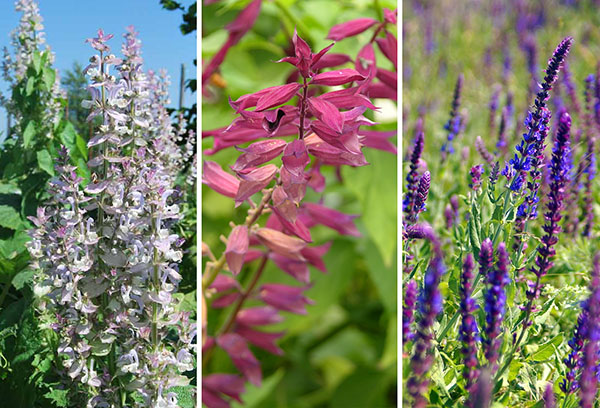
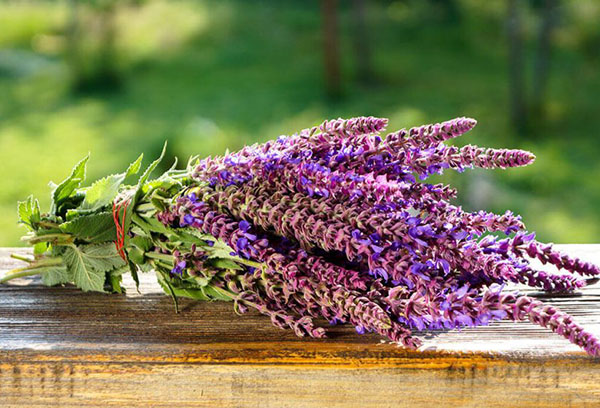
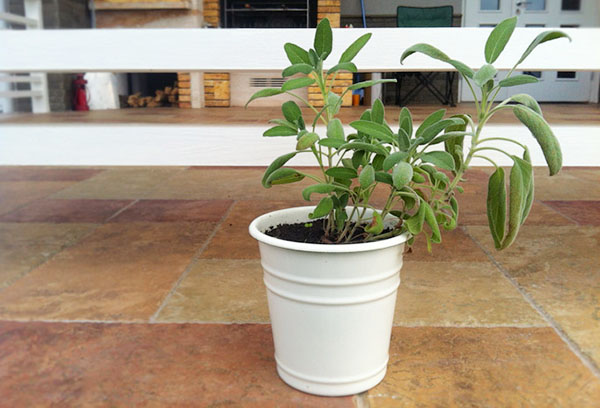
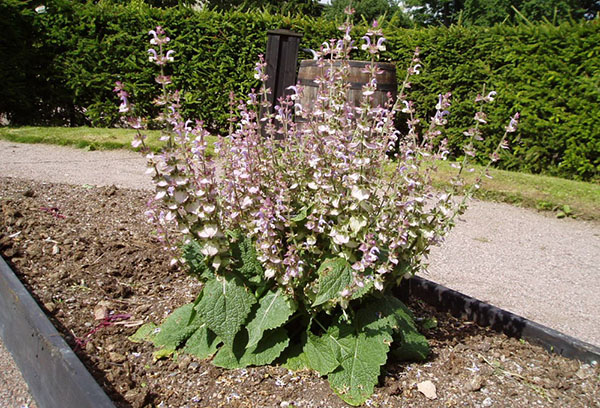
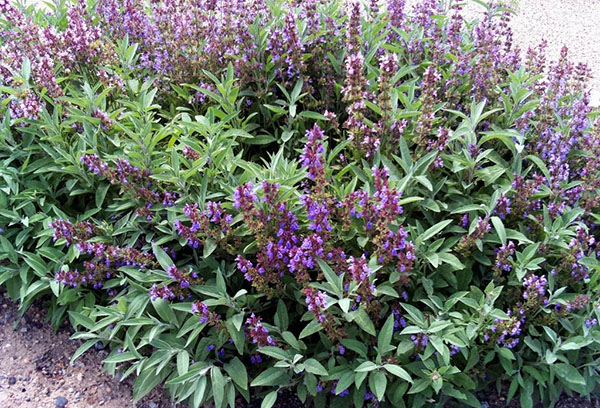
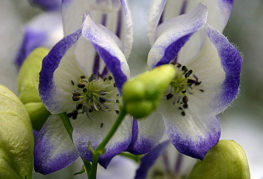
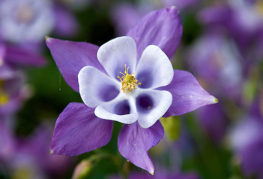
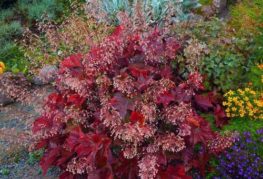
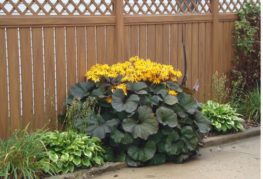
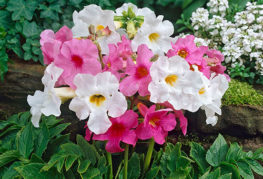
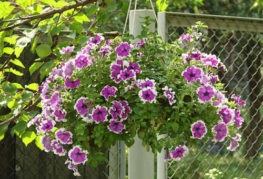
and will be published shortly.